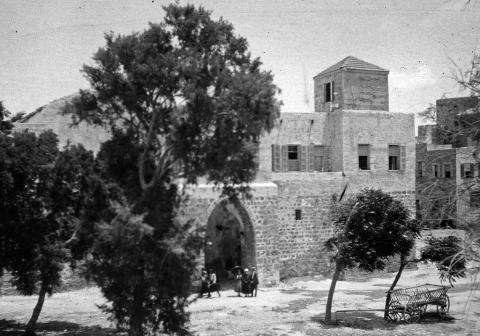Because of the marked individualism of those days in the Bahá’í community, there were many philosophical differences. The Bahá’ís of that time were immature in the ways of the Faith and ‘Abdu’l-Bahá used Corrine True to begin a transformation of the Bahá’í community. ‘Abdu’l-Bahá encouraged her to consult with the House of Spirituality, but disunity grew. Based on her talks with ‘Abdu’l-Bahá, she searched for a suitable Temple site north of Chicago while the House of Spirituality looked to the south. Finally, a site to the north, where the Temple now stands, was selected, though unity was far from complete.
Temples
Corinne True made one of her nine pilgrimages to the Bahá’í Holy Places in Palestine ‘during the time of the Second Commission of Investigation by the Turks, when ‘Abdu’l-Bahá had again been confined as a prisoner to ‘Akka by order of the Sultan of Turkey. On this visit Mrs True took a petition to the Master asking permission for the American Bahá’ís to begin planning for the erection of a “House of Worship”. This petition was in the form of a parchment containing the signatures of over a thousand American believers. She tells the story of putting the parchment behind her on the divan and first presenting the little gifts sent by the loving friends. But the Master strode across the room, reached behind her and grasped the parchment, holding it high in the air. “This,” He exclaimed, “this is what gives me great joy.” “Go back,” He told her, “go back and work for the Temple; it is a great work.” How she longed to do this work, but it seemed such a great task. ‘Abdu’l-Bahá, looking at her with deep intensity said, “Devote yourself to this project make a beginning, and all will come right.” He then proceeded to give basic instructions about its design. It was to have nine sides, nine gardens, nine fountains, nine doors, nine walks, etc. And so a vision of the first Bahá’í Temple in the Western Hemisphere was born.’
The final meeting was the Bahá’í Temple Unity Convention where 1000 people heard the Master speak on the significance of the Temple. From His talk, Corrine realized that the Temple wasn't something to unite the American Bahá’ís, but an instrument to unite all humankind.
When Corinne True was on pilgrimage in 1907, she brought with her a petition from the Chicago House of Spirituality (an early form of what would become a Bahá’í Spiritual Assembly), with the list of signatures of those who wish to build a Bahá’í House of Worship, the Mashriqu'l Adhkar. It was a rather audacious proposal from such a small group who really had no idea how audacious the idea actually was . . . After Mrs. True described the countryside around Chicago, ‘Abdu’l-Bahá told her that the Temple should be located away from the busy center of the city, but close to the shore of Lake Michigan because of the beauty of a lakeside location. He told her, first the building, with nine sides, in the middle; then a circular court about that; leading from the circle would be nine avenues; between each a garden, and in the middle of each garden a fountain of water. ‘Abdu’l-Bahá also told her that the project would cause her to suffer and be misunderstood, and that she would have to pray for strength. When she asked ‘Abdu’l-Bahá what He wanted her to do upon her return, He replied, "I wish you to live in Chicago. I wish you to work for the Mashriqu'l Adhkar." The Master then took her hand and she felt as though a great power was pulsing through her.
